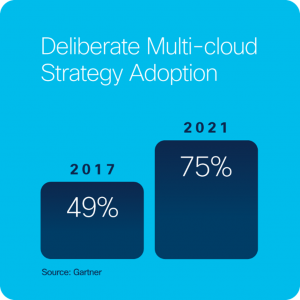Management of multi-cloud matures
 |
| Figure 1. Multi-cloud strategy adoption |
For enterprise IT organizations, the public cloud has become a staple at delivering software, infrastructure, security, and other capabilities at scale. Companies primarily adopt public cloud services for greater flexibility, faster time-to-market, and to take advantage of best-of-breed solutions while avoiding vendor lock-in. While SaaS platforms are the lion’s share of services consumed (48%), IaaS and PaaS combined make up 51% of public cloud spending (IDG).
When combined with an organization’s private cloud, the collective services available for business units to spin up applications and services rapidly help drive innovation and decrease the time-to-market. It’s no surprise that 74% of enterprises are now taking the best of both worlds and defining hybrid or multi-cloud strategies. In fact, the Boston-based research firm, IDC, has declared 2021 as the year of multi-cloud.
While cloud offerings have matured and consumption continues to increase, one could argue that how we manage multiple private and public cloud services has lagged consumption and is just now beginning to mature. Most IT organizations are experiencing a common set of challenges in how they and their internal customers manage their cloud services, how they can account for and identify owners of cloud services within their company, and a lack of visibility into the usage and costs for these services. In response, enterprises are now adopting a “deliberate” multi-cloud strategy — up from 49% in 2017 to 75% projected for 2021 by Gartner.
Evolving our multi-cloud management strategy
Like most enterprise organizations, Cisco has seen dramatic growth in the use of public cloud-based services over the past decade or more. In parallel, our internal infrastructure offerings continue to evolve in response to customer demand, and technological and feature advancements. Our challenges — which I’m sure we share with many — have included a lack of visibility into all the cloud services consumed (shadow IT), poor budgeting and cost control, inconsistent governance and security, and disparate user experiences.
Read More: 300-735: Automating and Programming Cisco Security Solutions (SAUTO)
To respond, Cisco IT set out in 2017 to craft a strategy with “single pane of glass” visibility into multi-cloud services. We drafted a blueprint to include a knowledge base about services and how to choose them, methods to ease integration with data- and API-driven capabilities, holistic audit and compliance capabilities with security in mind, and consolidated monitoring and metering capabilities with pay-as-you-go modeling.
“Our goal has been to build a solution that provided a unified experience for all of our customers, regardless of whether they were consuming public or private cloud services,” notes Mayank Jain, Director of Software Engineering at Cisco and a member of the team that has worked on the problem. “We needed a solution that provided the ability for our customers to consume different cloud services and see what it’s costing them over time, all through a single pane of glass.”
Figure 2. Value proposition
From the early stages, we looked to four sources to gain insight and understand how best to craft our solution — the industry for analysis and best practices, our customers for their cloud consumption needs and experiences, our internal service providers for their offerings and product roadmaps, and the solution providers. Our goal was to have a clear understanding of how cloud services are consumed, identify what patterns consumption follows, and gain insight into the best practices for managing multi-cloud, all while maintaining a healthy security and compliance stance. We also worked to understand how what we propose will impact our internal service providers and customers alike.
Not all clouds are alike
Our first challenge: Anyone who has tried to address this challenge knows that there is no single, unified way providers deliver account data and information, and APIs and management interfaces vary. This lack of uniformity makes it difficult to provide a single pane of glass for all cloud services being consumed. When modeling our solution, we worked to develop methodologies at the abstraction layer to pull the data from all providers that is then translated to a uniform display in the user interface.
As we were building our cloud management solution, Cisco IT was building its own private cloud. The new cloud service offerings are API-driven and engineered as an “as-a-Service” offering with faster deployment capabilities. Our goal has been to make these services behave and operate like public cloud offerings, moving away from traditional delivery methods that were customized for every instance. The resulting private cloud model is easily consumable, automated, measured, and based on pay-as-you-go pricing models. In this case, the multi-cloud management strategy influenced our internal provider teams but also allowed us to make public and private cloud models on par with each other for better standardization at the management level.
“We needed to understand better how to cost a service,” noted Kenny Jones, Principal Engineer and a key member of the team. “This change in mindset — one where infrastructure and services are commoditized through cloud-centric models — was one of the biggest challenges for our internal teams and this project. We changed our thinking to that of a service provider and educated our different providers in our private cloud.”
A purpose-built multi-cloud management solution
The Cisco IT MultiCloud Management Platform provides a unified management environment with a consistent experience for customers, regardless of what they’re ordering and managing. It offers automated purchasing and provisioning, reducing delays in getting applications and services to market — often in minutes rather than days or weeks.
“A key feature we felt vital to include in our solution was the ability to meter and measure hybrid cloud services over time,” states Kenny Jones. “This capability also allows our customers to project their cost obligations into the future. That type of visibility is key to maximizing the value of the service while also aiding in maximizing the lifecycle of the service required. That’s a game-changer in avoiding infrastructure sprawl and having assets live beyond their usefulness.”
The MultiCloud Management Platform incorporates a multi-tiered, persona-based administration environment. Based on their role, administrators and users are granted visibility and management capabilities through the same environment for viewing, operating, and administering their cloud service. It also provides key approval processes, including funding approvals and quota approval flows, where a customer wants to order specific services beyond standard levels.
The MultiCloud Management Platform also supports multi-tenancy for different groups. With this capability, business units within Cisco have visibility into and can manage multiple cloud services under one umbrella. These capabilities allow our customers to manage their costs as a single-tenant — an ability many service providers struggle to provide.
What’s next?
Already, the MultiCloud Management Platform has made a tremendous impact on productivity and started us down the road in managing infrastructure lifecycles and costs. In a recent conversation, one of our business unit leads and internal customers, noted to me, “You’re empowering us to make sure that we can oversee our resources correctly, optimize them for our budgets, and do our job the best we can. Through the tools you’ve made available, you’re going to help us a lot — and we’ve made some tremendous strides already.”
This new environment is more than just a new and updated interface. It has changed our strategic thinking by providing data that we didn’t have before or had to generate offline through spreadsheets and manual processes. Now, when spinning up and managing resources, we’re able to get a true picture of our costs, project their costs over time, and do it all faster than we could before.”
To date, the environment incorporates compute platforms, PaaS services, network and storage services, analytics, and other services. We will expand the services in the solution to include more public cloud services, like cloud-based software subscriptions in addition to enrolling private cloud solutions as they become available. Our goal is to continue evolving the solution to reduce the time involved in getting services by automating context-specific areas. Plus, we’re advancing multi-tenant capabilities by developing features that allow organizations to share templated setups and configurations that can straddle a customer group’s service subscriptions while sharing common traits, policies, and structures.
Source: cisco.com







0 comments:
Post a Comment